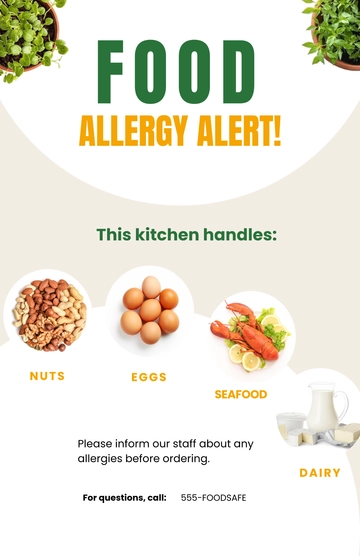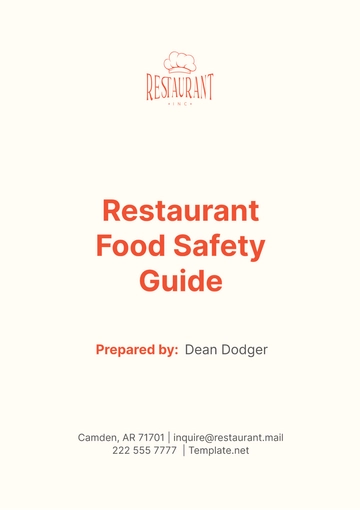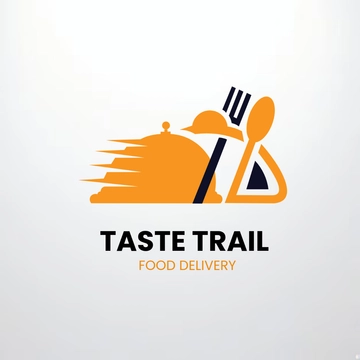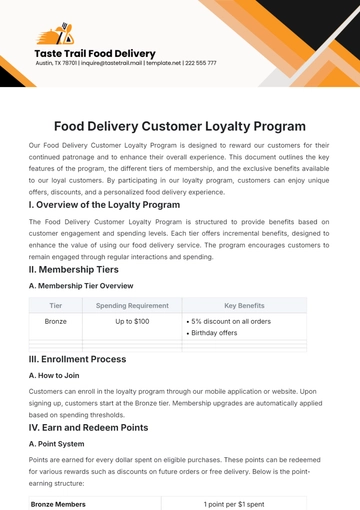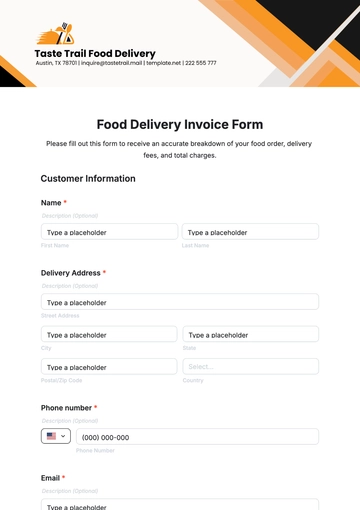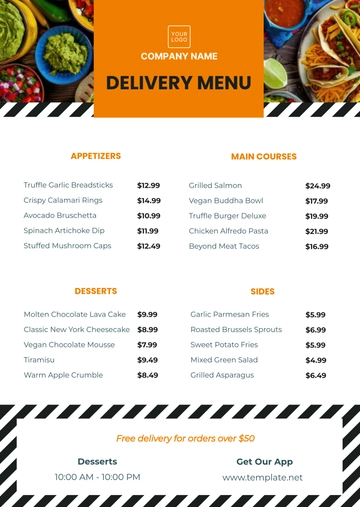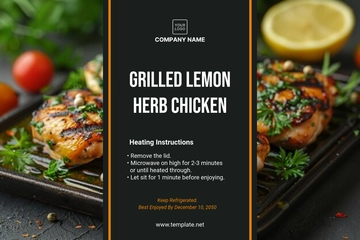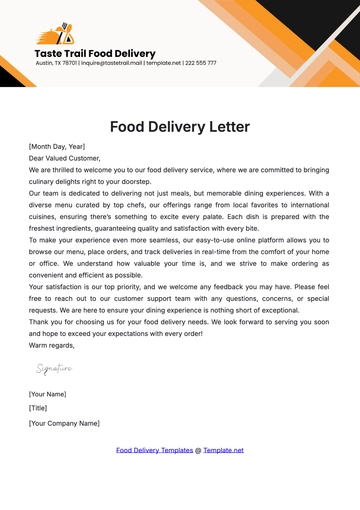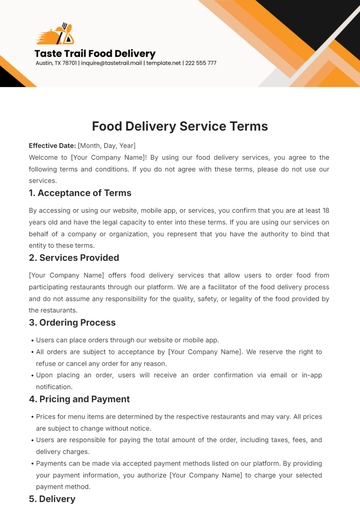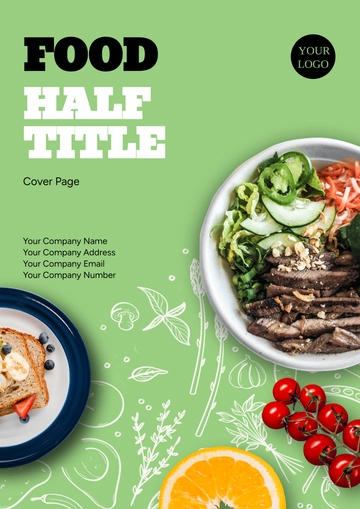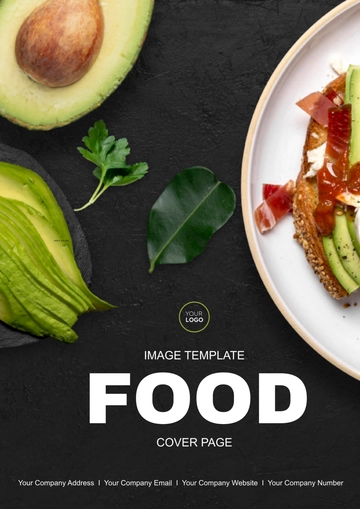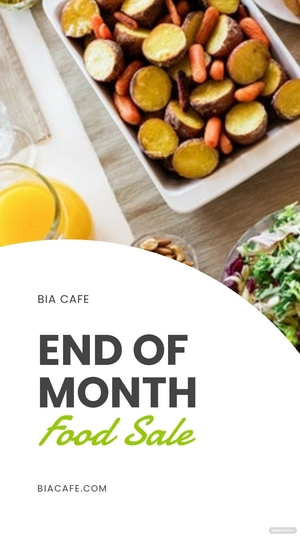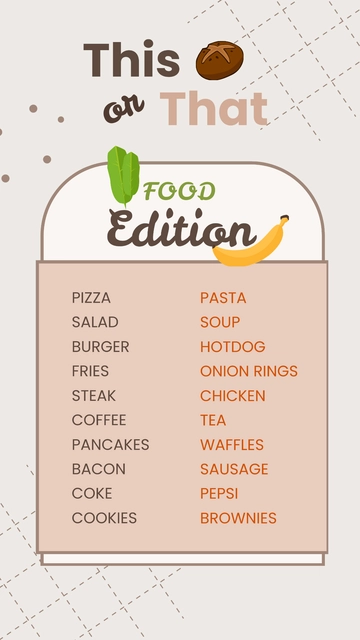Free Restaurant Food Safety Guide
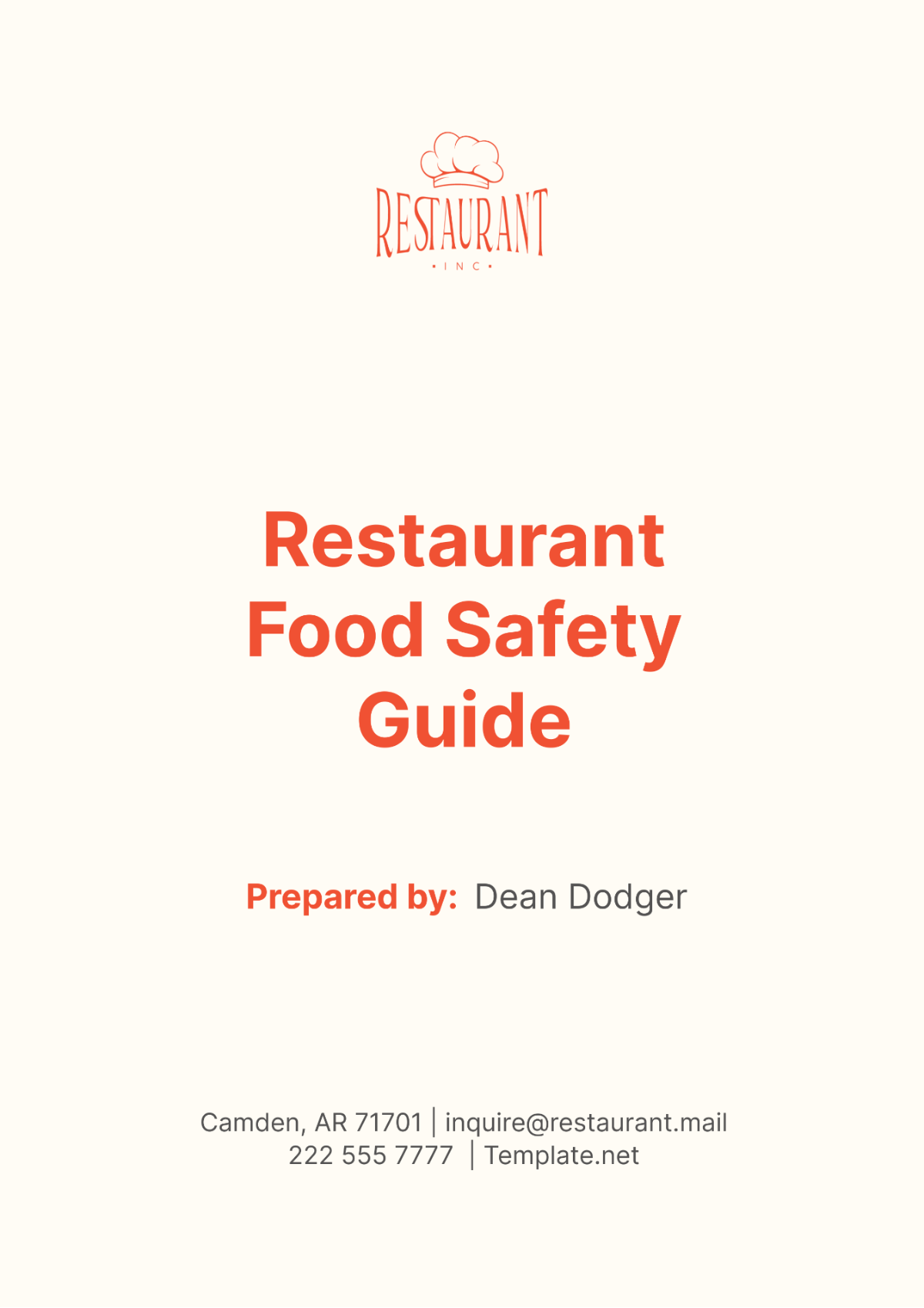
I. Introduction
Ensuring food safety is paramount in the restaurant industry. Adhering to guidelines and standards helps protect customers and enhances the establishment's reputation. This guide provides a thorough framework for maintaining food safety standards, ensuring that all food served is safe and of the highest quality. By following this guide, [Your Company Name] aims to prevent foodborne illnesses, promote best practices, and ensure compliance with US food safety regulations.
A. Purpose of the Guide
The purpose of this guide is to provide a comprehensive plan for food safety. It aims to ensure employees understand their roles and responsibilities and prevent foodborne illnesses. By following these guidelines, [Your Company Name] can maintain a safe and healthy environment for both employees and customers, ultimately enhancing the restaurant’s reputation.
Provide a comprehensive plan for food safety.
Ensure employees understand their roles and responsibilities.
Prevent foodborne illnesses.
B. Scope
This guide applies to all staff members working at [Your Company Name] and covers all aspects of food handling, preparation, and storage. It is relevant to every employee, from kitchen staff to management, emphasizing the importance of food safety at every level. The guide outlines procedures for receiving, storing, preparing, cooking, cooling, and serving food, ensuring that each step meets US food safety standards. By adhering to these guidelines, [Your Company Name] commits to maintaining a safe dining environment for all patrons.
II. Food Handling
Proper food handling is essential to prevent contamination and ensure the safety of the food served to customers. This section covers the critical aspects of receiving deliveries and maintaining personal hygiene, which are foundational practices for maintaining high food safety standards in the restaurant industry.
A. Receiving Deliveries
Receiving deliveries correctly is the first step in maintaining food safety. It is crucial to inspect all deliveries for signs of contamination and ensure that perishable items are stored at safe temperatures to prevent bacterial growth. This process helps to guarantee that only high-quality, safe ingredients enter the kitchen.
Inspect all deliveries for signs of contamination: Upon receiving any delivery, carefully check for damaged packaging, leaks, or any unusual odors that might indicate spoilage or contamination.
Verify temperature of perishable items using a calibrated thermometer: Use a calibrated thermometer to check the temperature of perishable items such as dairy, meat, and seafood. Ensure they are within safe temperature ranges (below 41°F for cold items and above 135°F for hot items).
Review and maintain delivery logs: Keep detailed records of all deliveries, including the date, time, supplier, and condition of the items received. This practice not only helps track inventory but also provides a record for food safety audits and traceability in case of a foodborne illness outbreak.
B. Personal Hygiene
Personal hygiene is vital in preventing foodborne illnesses and maintaining a clean and safe kitchen environment. All staff must adhere to strict hygiene practices to minimize the risk of contaminating food.
Wash hands thoroughly before and after handling food: Employees should wash their hands with soap and warm water for at least 20 seconds before starting work, after handling raw food, using the restroom, or touching their face, hair, or any potentially contaminated surfaces.
Wear clean uniforms and aprons: Staff should wear clean uniforms and aprons daily to prevent cross-contamination. Dirty clothing can harbor bacteria and other pathogens that can be transferred to food.
Use gloves when handling ready-to-eat foods: Gloves should be worn when handling ready-to-eat foods to create a barrier between hands and food, reducing the risk of contamination. Gloves should be changed frequently, especially after handling raw food, and hands should be washed before putting on a new pair.
III. Food Preparation
Proper food preparation is crucial for maintaining food safety and preventing foodborne illnesses. This section focuses on preventing cross-contamination and ensuring that foods are cooked to safe temperatures. Adhering to these guidelines helps to eliminate harmful pathogens and ensures that the food served to customers is safe to eat.
A. Preventing Cross-Contamination
Preventing cross-contamination is a key practice in maintaining food safety. It involves using specific tools and processes to ensure that raw and cooked foods do not come into contact with each other, which can lead to the spread of harmful bacteria.
Designate specific cutting boards and utensils for raw and cooked foods: Use color-coded cutting boards and utensils to distinguish between raw and cooked foods. For example, use red for raw meat, green for vegetables, and blue for cooked foods. This practice minimizes the risk of cross-contamination.
Store raw and cooked foods separately: Always store raw foods below cooked and ready-to-eat foods in the refrigerator to prevent juices or contaminants from dripping onto other items.
Clean and sanitize surfaces and equipment: Regularly clean and sanitize all work surfaces, equipment, and utensils after each use, especially after handling raw foods. Use appropriate cleaning agents and follow recommended procedures to ensure thorough sanitation.
Implement proper food handling procedures: Train staff on proper food handling procedures, including using separate gloves for different tasks and changing them frequently. Educate employees about the dangers of cross-contamination and the importance of maintaining a clean workspace.
B. Cooking Temperatures
Cooking food to the correct temperature is essential to kill harmful bacteria and ensure food safety. Each type of food has a specific minimum internal temperature that must be reached to be considered safe to eat. The following table outlines the safe cooking temperatures for various foods:
Food Type | Minimum Internal Temperature (°F) |
|---|---|
Poultry | 165 |
Beef | 145 |
Pork | 145 |
Seafood | 145 |
IV. Food Storage
Proper food storage is vital to maintaining food safety and quality in a restaurant. This section focuses on temperature control and the importance of labeling and dating food items. Adhering to these practices helps prevent spoilage, contamination, and foodborne illnesses, ensuring that customers receive safe and high-quality meals.
A. Temperature Control
Maintaining the correct temperatures for food storage is crucial to inhibit the growth of harmful bacteria and ensure food safety.
Store perishable items at or below 40°F: Refrigerators should be set to 40°F (4°C) or lower to slow bacterial growth and preserve the quality of perishable items such as dairy products, meats, and prepared foods. Regularly monitor and record refrigerator temperatures to ensure they remain within safe limits.
Keep frozen items at 0°F or below: Freezers should be maintained at 0°F (-18°C) or lower to keep food frozen solid and prevent the growth of bacteria. Regular temperature checks are essential to ensure the freezer is functioning correctly. Any signs of thawing or temperature fluctuations should be addressed immediately to prevent food spoilage.
Avoid overcrowding storage areas: Ensure that refrigerators and freezers are not overcrowded, as this can restrict airflow and lead to uneven temperatures. Proper organization allows for efficient cooling and easy access to stored items.
B. Labeling and Dating
Proper labeling and dating of food items are critical for maintaining food safety, quality, and efficient inventory management.
Label all items with the date of receipt: All food items should be clearly labeled with the date they were received or prepared. This practice helps track the age of items and ensures that older products are used first, reducing waste and the risk of using spoiled food.
Follow the "First In, First Out" (FIFO) method: Implement the FIFO method to manage inventory effectively. Place newer items behind older ones, ensuring that older products are used first. This practice helps maintain the freshness of ingredients and reduces the likelihood of food spoilage.
Include additional information on labels: Besides the date of receipt, labels should include the name of the item and any important details, such as allergens or special handling instructions. Clear labeling helps staff quickly identify and properly handle each item.
Regularly review and rotate stock: Conduct regular inventory checks to ensure that all items are within their use-by dates and that older items are used before newer ones. Discard any expired or spoiled items immediately to prevent contamination.
V. Cleaning and Sanitation
Maintaining a clean and sanitary environment is crucial for ensuring food safety and preventing foodborne illnesses. This section outlines the daily and weekly cleaning procedures necessary to keep the restaurant in compliance with health standards and provide a safe environment for both employees and customers.
A. Daily Cleaning Checklist
Daily cleaning routines are essential to maintain a hygienic kitchen and dining area. Consistent and thorough cleaning helps prevent the buildup of food residues and bacteria, ensuring a safe environment for food preparation and service.
Clean and sanitize all food-contact surfaces: At the end of each shift, all food-contact surfaces, including countertops, cutting boards, and utensils, should be cleaned and sanitized using appropriate cleaning agents. This prevents cross-contamination and the spread of harmful bacteria.
Sweep and mop floors: Floors should be swept and mopped daily to remove food particles, spills, and debris. Use a suitable floor cleaner and ensure that high-traffic areas are given extra attention. Clean floors help prevent slips, falls, and the attraction of pests.
Empty and sanitize trash bins: Trash bins should be emptied regularly throughout the day and sanitized at the end of each shift. This prevents the buildup of odors and bacteria and reduces the risk of attracting pests. Ensure that bins have liners and lids to contain waste effectively.
B. Weekly Deep Cleaning
Weekly deep cleaning tasks are more intensive and help maintain a high standard of cleanliness throughout the restaurant. These tasks address areas that may not require daily attention but are crucial for preventing long-term buildup of dirt and grime.
Task | Details |
|---|---|
Disassemble and clean equipment | Disassemble kitchen equipment such as slicers, mixers, and grills. Clean and sanitize all parts thoroughly, ensuring that no food residue remains. |
Wipe down walls and ceilings | Clean walls and ceilings, especially in cooking areas, to remove grease, dust, and other buildup. Use appropriate cleaning agents and tools for each surface. |
Inspect pest control measures | Check for signs of pests and ensure all pest control measures are in place and effective. This includes inspecting traps, seals, and potential entry points. |
Clean storage areas | Empty and clean shelves, drawers, and cabinets in storage areas. Ensure that all food items are stored properly and that no expired or spoiled items are present. |
Maintain ventilation systems | Clean and inspect hoods, vents, and filters to ensure proper airflow and reduce the buildup of grease and other contaminants. |
Sanitize high-touch surfaces | Sanitize doorknobs, handles, switches, and other frequently touched surfaces to prevent the spread of germs and bacteria. |
VI. Employee Training
Employee training is essential to maintain high food safety standards and ensure that all staff members are knowledgeable about proper procedures and practices. Regular training sessions help reinforce important concepts, update staff on new regulations, and ensure consistent application of food safety measures across the restaurant. This section outlines the training schedule and the key topics covered in these sessions.
A. Training Schedule
The training schedule ensures that all employees, from new hires to seasoned staff, receive the necessary education and updates on food safety practices. This schedule includes initial orientation, regular refresher courses, and annual certification updates to maintain compliance with food safety regulations.
Training Session | Frequency | Details |
|---|---|---|
Orientation Session | Upon Hiring | Comprehensive introduction to food safety protocols, personal hygiene, and proper food handling practices for all new hires. |
Quarterly Refresher Courses | Every Three Months | Review of key food safety concepts, updates on any new regulations or procedures, and reinforcement of best practices. |
Annual Certification Updates | Once a Year | Mandatory certification renewal covering all aspects of food safety, including new laws and advanced techniques. |
B. Topics Covered
Employee training sessions cover a range of essential topics to ensure that all staff members are well-versed in maintaining food safety standards. These topics include:
Foodborne illness prevention
Personal hygiene practices
Proper food handling and storage techniques
VII. Incident Management
Effective incident management is critical for addressing food safety issues promptly and preventing further harm. This section outlines the procedures for reporting incidents and the response plan to handle them. Ensuring that all employees are familiar with these steps helps maintain a safe dining environment and comply with health regulations.
All employees must report any signs of foodborne illness or unsafe conditions immediately to a supervisor. The following six steps outline the proper reporting procedures:

Identify the Issue: Recognize signs of potential foodborne illness or unsafe conditions, such as unusual symptoms among customers or staff, or contamination risks in the kitchen.
Notify a Supervisor: Immediately report the issue to the on-duty supervisor or manager, providing as much detail as possible.
Document the Incident: Record the incident in the appropriate log, including date, time, affected individuals, and a description of the issue.
Follow Health and Safety Protocols: Adhere to any immediate safety protocols, such as isolating the affected area or removing contaminated food items from service
Seek Medical Attention: If necessary, ensure that any affected individuals receive appropriate medical attention.
Maintain Confidentiality: Keep all details of the incident confidential and discuss them only with relevant personnel and health authorities.
VIII. Conclusion
Adhering to the guidelines outlined in this Food Safety Guide is essential to maintaining a safe and hygienic environment at [Your Company Name]. Consistent application of these practices will help ensure the health and satisfaction of our customers.
For more information, please contact [Your Company Name] at [Your Company Email] or visit our website at [Your Company Website].
- 100% Customizable, free editor
- Access 1 Million+ Templates, photo’s & graphics
- Download or share as a template
- Click and replace photos, graphics, text, backgrounds
- Resize, crop, AI write & more
- Access advanced editor
Introducing Template.net's Restaurant Food Safety Guide Template – your essential resource for maintaining high standards of hygiene and safety in the food service industry. This editable and customizable template ensures clarity and compliance with food safety regulations. Tailored for thoroughness, it's editable in our Ai Editor Tool, offering seamless customization. Protect your customers and your reputation with a comprehensive food safety guide that covers best practices, sanitation protocols, and employee training.
You may also like
- Food Flyer
- Food Clipart
- Food Truck
- Food Business Plan
- Food Banner
- Food Checklist
- Food Voucher
- Food Chart
- Food Letter
- Food Log
- Food Ticket
- Food Poster
- Food Brochure
- Food Business Contract
- Food Proposal
- Food Lookbook
- Food Invitation
- Food Budget
- Food Magazine
- Food Calorie Chart
- Food Facebook Post
- Food Label
- Food Catalog
- Food Menu
- Food Drive Flyer

